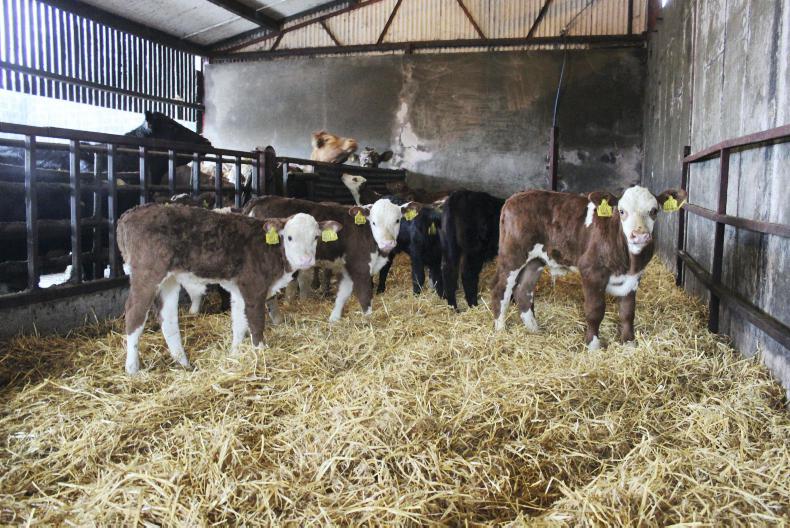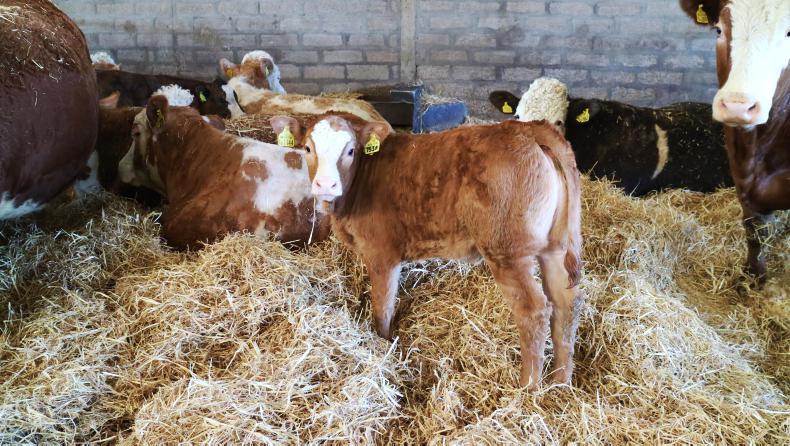Calf scour is the leading cause of mortality in suckler herds. Scour causes diarrhoea as the result of damage in the gut due to an infection.
The three main causes of scour are parasites, virus and bacteria.
The earlier you pick up the symptoms of a scour problem, the more effective the treatment will be and the animal will recover faster.
Knowing what you are looking for prevents you from mis-diagnosing the problem and giving the wrong course of treatment.
Outlined below are five steps to reduce the risk of calf scour entering your herd this winter.
1. Clean calving pens
Calving pens are a leading source of scour in young calves. As the calf is born without any immunity, calving pens must be kept clean and dry, as this is the animal’s first point of contact with the world.
Ideally, these pens should be cleaned out after every use, but this is not always practical. Therefore, clean every few days and continue to apply extra bedding in between.
Keeping cows on drier fodder just prior to and after calving will keep dung firmer and reduce the rate that bedding is soiled.
Wash out pens and disinfect thoroughly. Allow to dry before re-bedding, as wet floors provide an ideal environment for scour pathogens.
2. Clean bedding
For healthy calves, having a clean, dry, straw bed available is paramount. Wet bedding is a breeding ground for disease.
It also reduces the calf’s core body temperature, making it more susceptible to infection.
A rule of thumb for bedding calf creeps is that when you kneel down on the straw, your knees should be completely dry.

Calves should have access to a separate creep area which offers a clean, dry bed to lie on.
3. Clip cows
Wet silage and housing on slats will cause cows to become dirty along the belly, around the udder and hind legs.
As the newborn calf tries to suckle it’s mother for the first time, it will suck on hair coated in faeces on the belly before it locates the udder. This increases the risk of crypto and coccidiosis getting into the young calf’s gut.
Use proper handling facilities to restrain the cow and clip along the belly, udder, hind leg and tail.
4. Colostrum
Getting plenty of colostrum into the calf in the first two hours of life gives the animal the best possible start.
Remember that there is little point in vaccinating against scour if calves are not getting adequate colostrum.
Ideally, a calf should receive around two litres of colostrum inside the first two hours of calving. While this is easier to carry out in a dairy herd, for suckler farmers it is less practical.
Therefore, ensuring the calf has sucked the cow for at least 20 minutes in the first two hours of life should see the animal get adequate colostrum.
If you have to use a stomach tube, make sure the tube has been sterilised after the previous use.
Remember that the tube is placed directly into the calf’s stomach. Therefore, a dirty tube transmits infection straight to the stomach before the calf has even received colostrum.
5. Treat all suspected calves
If you have a problem with scour, it may be a good idea to treat all calves in the group rather than just the one or two calves showing symptoms.
Other calves can be infected, but it may be too early to for them to start showing symptoms. These animals may need treated within a few days.
Always consult with your vet for the best course of action.
Read more
Shortage of salmonella vaccine
Vet’s corner: salmonella abortions
Weanling exports to Turkey easing off
Calf scour is the leading cause of mortality in suckler herds. Scour causes diarrhoea as the result of damage in the gut due to an infection.
The three main causes of scour are parasites, virus and bacteria.
The earlier you pick up the symptoms of a scour problem, the more effective the treatment will be and the animal will recover faster.
Knowing what you are looking for prevents you from mis-diagnosing the problem and giving the wrong course of treatment.
Outlined below are five steps to reduce the risk of calf scour entering your herd this winter.
1. Clean calving pens
Calving pens are a leading source of scour in young calves. As the calf is born without any immunity, calving pens must be kept clean and dry, as this is the animal’s first point of contact with the world.
Ideally, these pens should be cleaned out after every use, but this is not always practical. Therefore, clean every few days and continue to apply extra bedding in between.
Keeping cows on drier fodder just prior to and after calving will keep dung firmer and reduce the rate that bedding is soiled.
Wash out pens and disinfect thoroughly. Allow to dry before re-bedding, as wet floors provide an ideal environment for scour pathogens.
2. Clean bedding
For healthy calves, having a clean, dry, straw bed available is paramount. Wet bedding is a breeding ground for disease.
It also reduces the calf’s core body temperature, making it more susceptible to infection.
A rule of thumb for bedding calf creeps is that when you kneel down on the straw, your knees should be completely dry.

Calves should have access to a separate creep area which offers a clean, dry bed to lie on.
3. Clip cows
Wet silage and housing on slats will cause cows to become dirty along the belly, around the udder and hind legs.
As the newborn calf tries to suckle it’s mother for the first time, it will suck on hair coated in faeces on the belly before it locates the udder. This increases the risk of crypto and coccidiosis getting into the young calf’s gut.
Use proper handling facilities to restrain the cow and clip along the belly, udder, hind leg and tail.
4. Colostrum
Getting plenty of colostrum into the calf in the first two hours of life gives the animal the best possible start.
Remember that there is little point in vaccinating against scour if calves are not getting adequate colostrum.
Ideally, a calf should receive around two litres of colostrum inside the first two hours of calving. While this is easier to carry out in a dairy herd, for suckler farmers it is less practical.
Therefore, ensuring the calf has sucked the cow for at least 20 minutes in the first two hours of life should see the animal get adequate colostrum.
If you have to use a stomach tube, make sure the tube has been sterilised after the previous use.
Remember that the tube is placed directly into the calf’s stomach. Therefore, a dirty tube transmits infection straight to the stomach before the calf has even received colostrum.
5. Treat all suspected calves
If you have a problem with scour, it may be a good idea to treat all calves in the group rather than just the one or two calves showing symptoms.
Other calves can be infected, but it may be too early to for them to start showing symptoms. These animals may need treated within a few days.
Always consult with your vet for the best course of action.
Read more
Shortage of salmonella vaccine
Vet’s corner: salmonella abortions
Weanling exports to Turkey easing off







 This is a subscriber-only article
This is a subscriber-only article










SHARING OPTIONS: